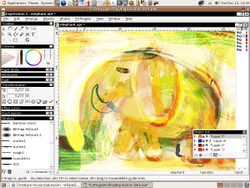Creature House Expression
Creature House Expression was an award-winning vector graphics editor developed by Creature House in Hong Kong, founded by Alex S.C. Hsu and Irene H. H. Lee. It was initially marketed through a developer/publisher agreement with Ray Dream Inc. subsequently Fractal Design Corporation and later MetaCreations under the trade name Fractal Design Expression. [1] The software was positioned as a companion to then-Fractal Design/MetaCreations Painter. Creature House regained full marketing rights from MetaCreations Corp. in late 2000 and published version 2 of the software under its own name as Creature House Expression. [2] [3] [4] The latest version of Creature House Expression published by Creature House Ltd is version 3.3.
 Screenshot of Creature House Expression 3.3.372 | |
| Developer(s) | Creature House, now acquired by Microsoft |
|---|---|
| Stable release | 3.3.372
/ Nov 2003 |
| Operating system | Microsoft Windows, Mac OS X |
| Type | Vector graphics editor with skeletal stroke capability |
| License | Freeware Proprietary EULA |
| Website | www.microsoft.com |
In Sep 2003, Microsoft acquired the software product together with all related trademarks and titles and hired Dr. Alex S. C. Hsu as an architect. Eventually, Alex S. C. Hsu led a new Microsoft team to continue the development of the software under the code name Acrylic[5] as part of a new Expression Suite Project initiated by Alex S. C. Hsu and others. In 2007, the original Expression application became part of Microsoft's Expression Studio suite of applications, rebranded and rewritten in WPF as Microsoft Expression Design. Windows XP and Vista versions are available, although Mac OS X support was officially discontinued.
Skeletal stroke
Expression uses a unique technology called skeletal stroke. There have been a few research papers on this technology, including the work of Alex S. C. Hsu and Irene H. H. Lee,[6] who are the original developers of Expression.
LivingCels
Along with Expression, Create House also developed animation software called LivingCels, featuring the same technology, including skeletal strokes, as in Expression [7]. LivingCels was released as a public preview [8], but never made it to final release after Creature House was purchased by Microsoft.
See also
- Microsoft Expression Design, the new product based on Creature House Expression
- List of vector graphics editors
- Comparison of vector graphics editors
References
- "About Creature House". Archived from the original on 2013-02-16.
- Susan Glinert Stevens (August 27, 2001). "Expression 2: Natural Media the Vector Way".
- David Nagel (October 19, 2001). "Creature House Expression 2".
- David Nagel (April 17, 2002). "Creature House Expression 2.4.1".
- https://www.pcmag.com/article2/0,2817,1833044,00.asp
- Siu Chi Hsu; Irene H. H. Lee (1994). Drawing and animation using skeletal strokes. New York, NY, USA: ACM. doi:10.1145/192161.192186. ISBN 0-89791-667-0.
- "About Creature House". LivingCels. Archived from the original on 20 June 2008. Retrieved 20 June 2008.
- Neowin Staff. "Microsoft's Creature House Acquisition". Neowin. Retrieved 21 October 2018.
- Marvin Guerrero (August 24, 2012). "Fan Page".
- Fott, Galen (September 28, 2005). "Creature House Expression 3". PC Magazine. Retrieved February 28, 2012. External link in
|publisher=(help) - Nagel, David (November 6, 2003). "Update: Microsoft's Creature House Acquisition". Creativemac.com. Retrieved February 28, 2012. External link in
|publisher=(help) - LeMay, Renai (June 10, 2005). "Microsoft offers beta of Adobe rival". CNET News. Retrieved February 28, 2012. External link in
|publisher=(help)
External links
Download Creature House Expression from Microsoft
- Archive.org archive of home page
- Microsoft Expression 3.3 Freeware Windows version (57.3 MB), requires (No longer available) registration
- , Microsoft Expression 3.3 Freeware Windows version direct link to above file, does not require registration
- Microsoft Expression 3.3 Freeware Mac OS 8/9/X version (55.8 MB), requires registration; there are versions for Mac OS 8/9 and Mac OS X in the archive
- Update to Mac OS X version for Mac OS 10.3.5; fixes a startup problem (2.9 MB), no registration required
- November 1996: Fractal Design Ships Expression for Macintosh